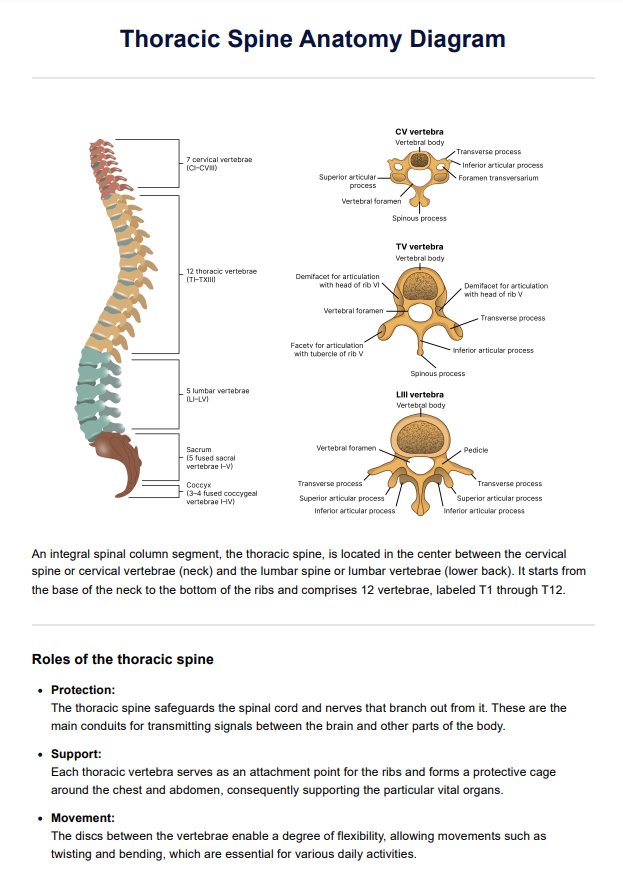Thoracic Spine Anatomy Diagram
Use our Thoracic Spine Anatomy Diagram to get a better understanding of the thoracic spine's anatomy, purposes, and functions for educational and medical purposes.


What is the thoracic vertebrae?
An integral spinal column segment, the thoracic spine, is located in the center between the cervical spine or cervical vertebrae (neck) and the lumbar spine or lumbar vertebrae (lower back). It starts from the base of the neck to the bottom of the ribs and comprises 12 vertebrae, labeled T1 through T12.
The thoracic region is known for it's role in mobility, support, and protection of vital organs. To elaborate, the vital roles it plays are:
- Protection: The thoracic spine safeguards the spinal cord and nerves that branch out from it. These are the main conduits for transmitting signals between the brain and other parts of the body.
- Support: Each thoracic vertebra serves as an attachment point for the ribs and forms a protective cage around the chest and abdomen, consequently supporting the particular vital organs.
- Movement: The discs between the vertebrae enable a degree of flexibility, allowing movements such as twisting and bending, essential for various daily activities and more.
Despite it's robust structure needed for it's role in the body, the thoracic spine is susceptible to a range of impairments and injuries such as trauma, degenerative conditions, infections, tumors, and muscular problems like irritation or tension.
Thoracic Spine Anatomy Diagram Template
Thoracic Spine Anatomy Diagram Example
What is a Thoracic Spine Anatomy Diagram?
A Thoracic Spine Anatomy Diagram is a vital tool that medical students and healthcare professionals can use to understand the complex structure and functions of this central segment of the spine. Typically, you can expect the detailed diagram to highlight the following key anatomical features in the thoracic region:
- Vertebral bodies: Vertebral bodies are the thick, cylindrical parts of each vertebra that are stacked up, separated by intervertebral discs, that bear most of the body's weight. Each vertebral body plays a crucial role, in weight-bearing, support, and other structural functions.
- Intervertebral discs: Intervertebral discs, which act as cushioning pads, are located between each pair of vertebrae. Each intervertebral disc allows for flexibility and movement, absorbing shock and reducing friction between vertebrae.
- Facet joints: Facet joint are cartilaginous joints that allow the sliding of vertebrae which helps with stability and flexibility.
- Spinous processes: Spinal processes are boy projections that extend posteriorly from each vertebra. Not only do they serve as attachment points for muscles and ligaments for movement and spine stability, but they also offer additional protection to the spinal cord.
Other anatomical features present in diagrams are transverse processes, soft tissues, rib attachments, spinal canal, spinal cords and spinal nerves.
How to use our Thoracic Spine Anatomy Diagram template
A Thoracic Spine Anatomy Diagram is an essential tool for medical students and healthcare professionals, aiding in anatomy mastery, diagnosis, treatment planning, patient education, and more.
Here's a step-by-step guide on to make the most of the diagram for educational and clinical purposes:
Step 1: Familiarization with content
Go over the diagram and read the information in the template. Familiarize yourself with the anatomy of the thoracic vertebrae, it's role, and the purpose of each key anatomical feature. Feel free to write down mnemonics or notes to better understand or memorize the anatomy in the space provided at the bottom of the template.
Step 2: Utilization
Use the template when studying, conducting a patient assessment, comparing with imaging, treatment planning, explaining the patient's condition, or demonstrating a procedure to a patient. Should the need arise, you may annotate clinical findings and track the patient's progress with the diagram and notes section provided.
Step 3: Next steps
Whether you're using the digital or printed version, you can share your diagram during training sessions or when formulating a diagnosis or treatment with other healthcare professionals involve. This template will serve as a common reference point when understanding the anatomy or discussing a paient's case.
Benefits of using this Thoracic Spine Anatomy Diagram
Using a thoracic spine diagram offers several benefits:
- Visual Learning: Diagrams clearly represent the thoracic spine, making it easier to understand its structure and function.
- Educational tool: They are helpful for teaching and learning, helping students and healthcare professionals grasp complex anatomical details.
- Patient education: Doctors can use diagrams to explain conditions, injuries, or treatments to patients, enhancing their understanding and involvement in their care.
- Diagnosis and treatment planning: Diagrams help identify specific areas of concern, aiding in accurate diagnosis and effective treatment planning.
- Reference for procedures: Surgeons and other medical professionals use anatomical diagrams as references during procedures to ensure precision and safety.
Common treatments for thoracic spine problems
Treatment options for thoracic spine problems vary widely, depending on the specific condition and its severity. Effective management typically involves a combination of conservative, interventional, surgical, and lifestyle approaches. Below are some of the most common treatments:
- Conservative treatments: Conservative treatments for thoracic spine problems include physical therapy, medication, bracing, ice or heat therapy, and activity modification.
- Interventional treatments: Interventional treatments include injections, chiropractic care, and massage therapy.
- Surgical treatments: Surgical treatments include minimally invasive procedures, spinal fusion, and decompression surgery.
- Lifestyle modifications: Lifestyle modifications include learning how to maintain good posture, exercise, and proper nutrition.
Commonly asked questions
Inflammation due to a sprain or strain and poor posture is the most common cause of thoracic spine pain.
Should something happen to the thoracic spine, the ones that will be affected are the heart and lungs.
The nerve roots in the thoracic spine is in charge of sending sensory and motor signals for the areas from the upper back to the abdomen.







































































































